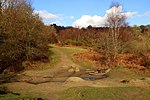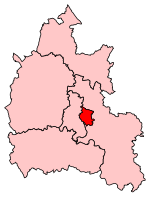Risinghurst and Sandhills
Civil parishes in OxfordshireGeography of OxfordLocal government in OxfordOxfordshire geography stubs

Risinghurst and Sandhills is a civil parish in the city of Oxford, Oxfordshire, England. It consists of Risinghurst and Sandhills, two areas in the east of Oxford, east of the junction of the A40 and the A4142. It is elongated, excludes green space to the north, south and east and is approximately l-shaped, traversing two dual carriageways at right angles; these are crossed by a bridge and a subway and the density of the area is relatively homogenous. As at the 2011 census, it had a population of 4,237. Its contiguous neighbours are New Headington (the denser Headington Quarry neighbourhood) and Barton to the west.
Excerpt from the Wikipedia article Risinghurst and Sandhills (License: CC BY-SA 3.0, Authors, Images).Risinghurst and Sandhills
Claymond Road, Oxford Barton
Geographical coordinates (GPS) Address Nearby Places Show on map
Geographical coordinates (GPS)
| Latitude | Longitude |
|---|---|
| N 51.7625 ° | E -1.1888888888889 ° |
Address
MacIntyre Academies Endeavour Academy
Claymond Road
OX3 8BU Oxford, Barton
England, United Kingdom
Open on Google Maps









